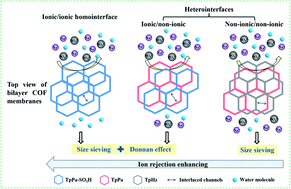Homointerface covalent organic framework membranes for efficient desalination†
Abstract
Covalent organic frameworks (COFs) are an emergent class of crystalline porous polymers featuring a long-range regular pore structure, high porosity and excellent chemical stability. Bilayer COF membranes with tunable interfaces hold great promise in ionic and molecular separations. Herein, we designed a series of bilayer COF membranes with homointerface and heterointerface, which achieved efficient desalination performance through manipulating the interface confinement effect. COF membranes were prepared on a porous support through successively regulating the growth of imine-based 2D COF layers by in situ growth and counter-diffusion approach at ambient temperature. Narrowed sub-nanometer interlaced channels were created at the interface of the two adjacent COF layers. The rejection rate of homointerface COF membrane toward Na2SO4 was higher than that of heterointerface COF membranes, which was due to the synergistic enhancement of interface-confined size sieving and Donnan effect. The homointerface TpPa–SO3H/TpPa–SO3H/MPAN membrane exhibits a rejection rate of 98.3% for Na2SO4 and water flux of 13.1 L m−2 h−1 bar−1, which is the highest performance among COF desalination membranes ever reported.



 Please wait while we load your content...
Please wait while we load your content...